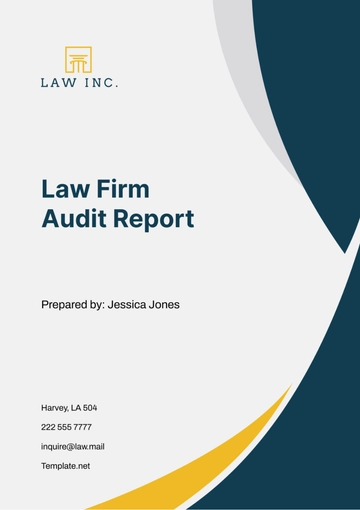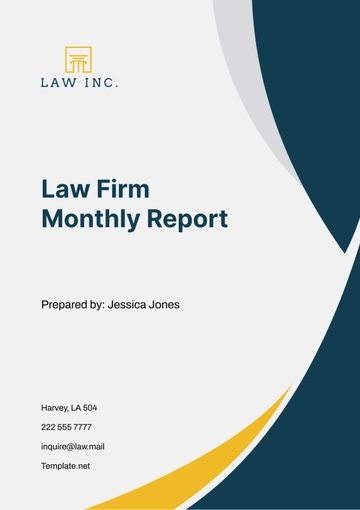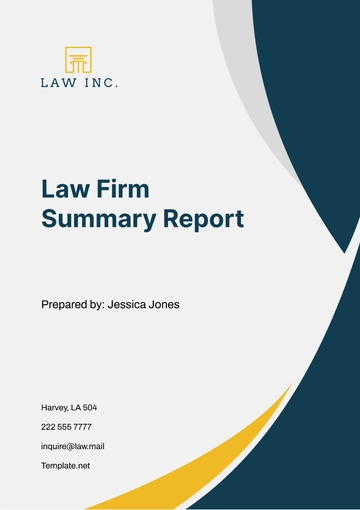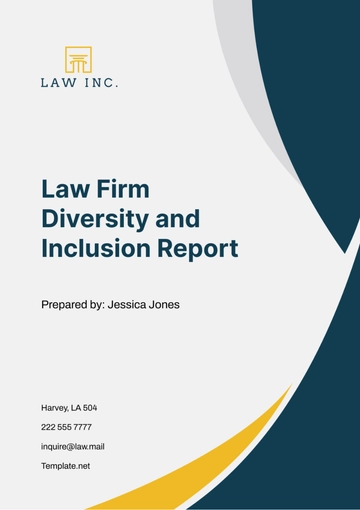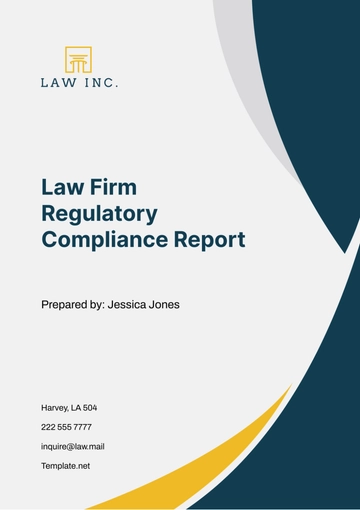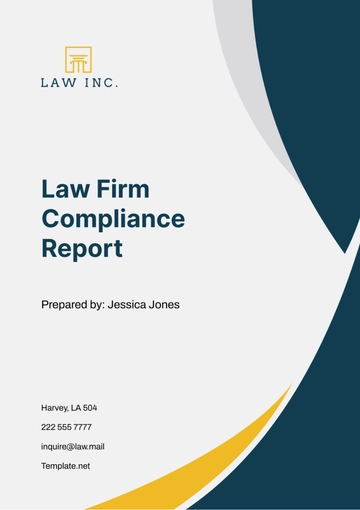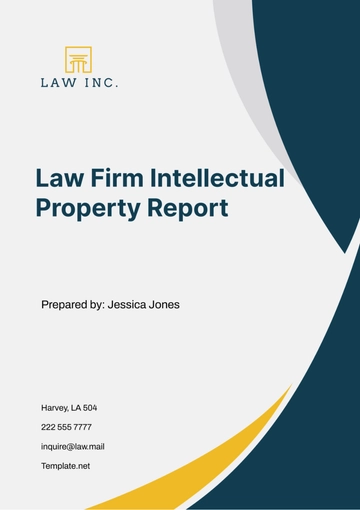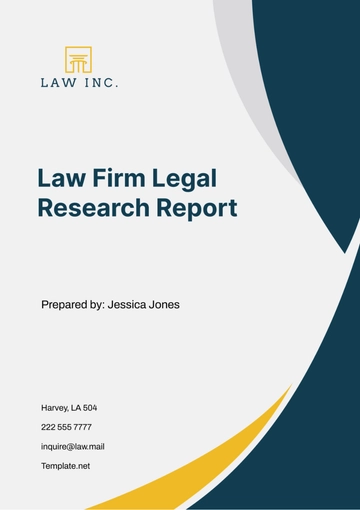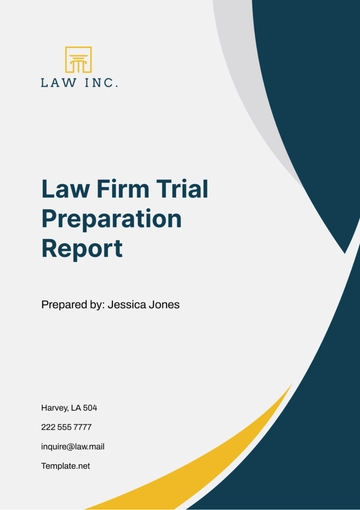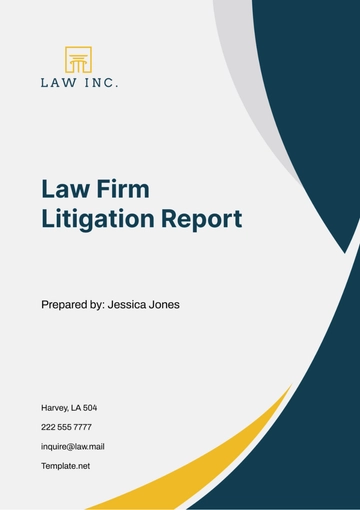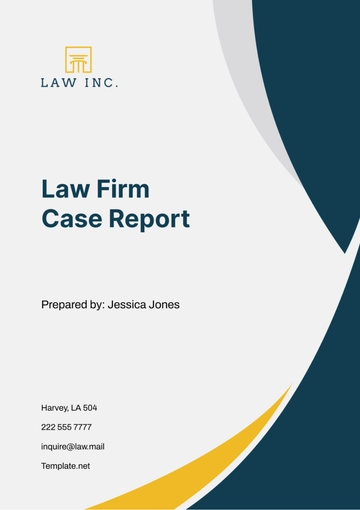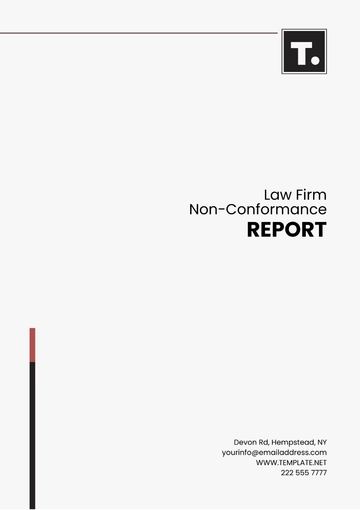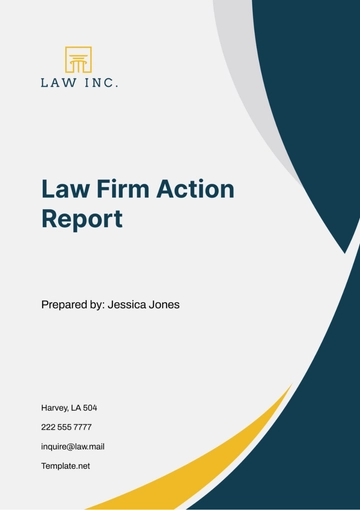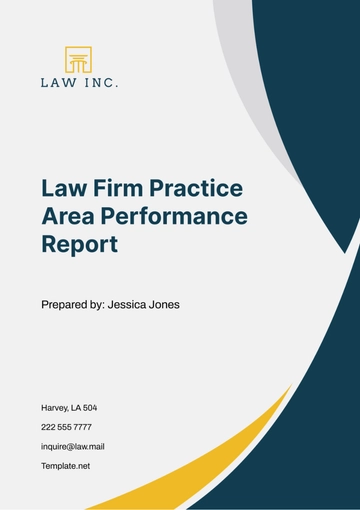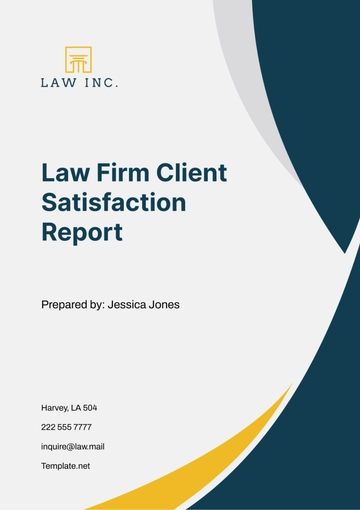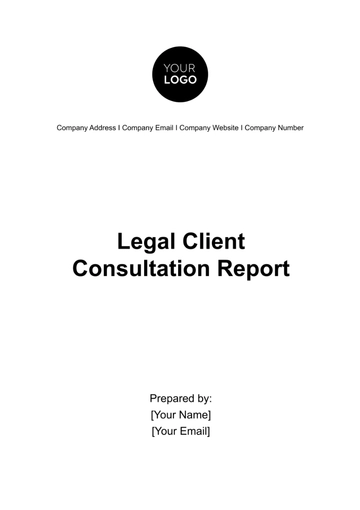Free Law Firm Audit Report
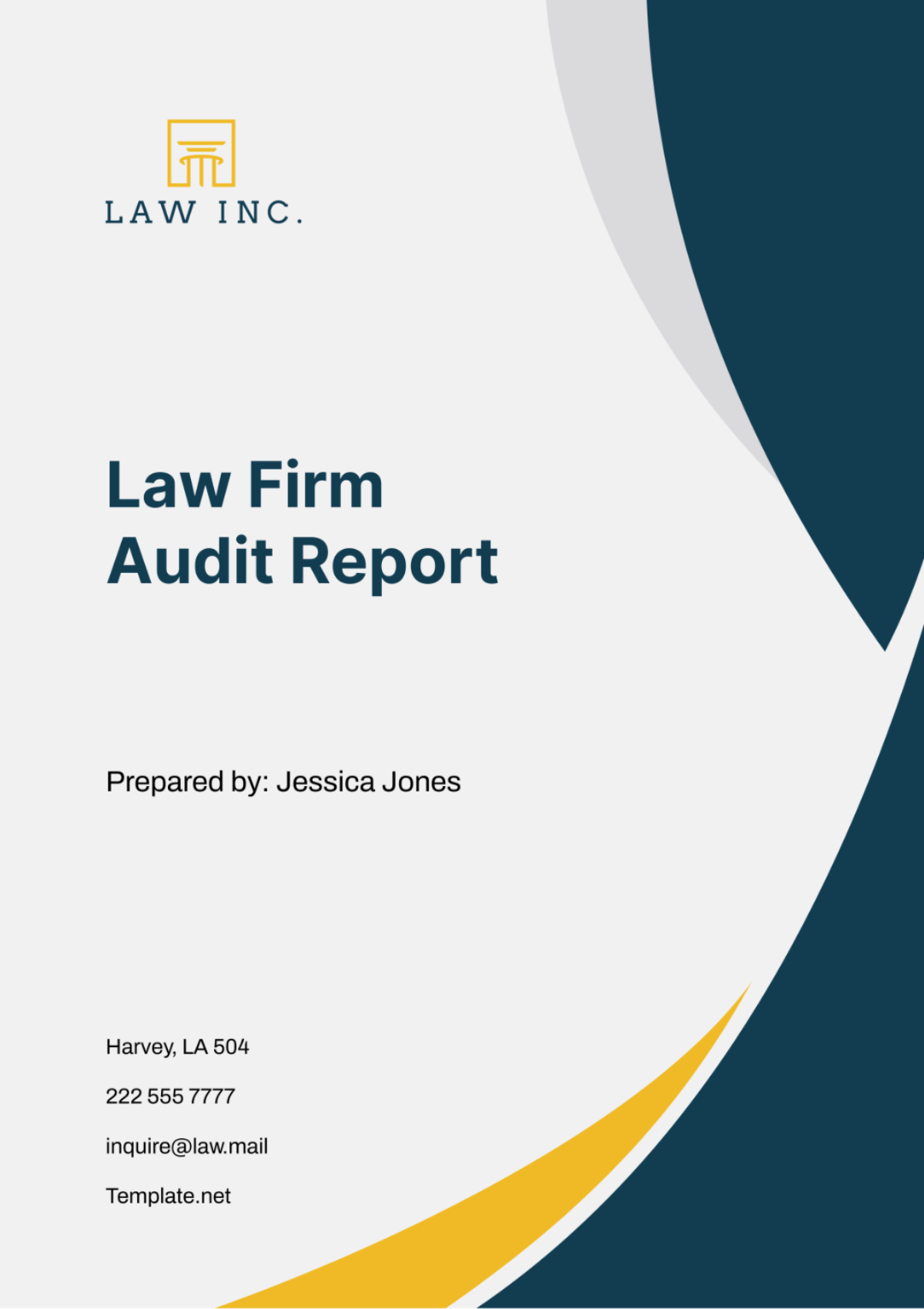
I. Executive Summary
The audit of [Your Company Name] was conducted to assess its financial performance, compliance with regulatory requirements, and operational efficiency. The firm has shown commendable financial stability, with consistent revenue growth over the audit period. However, there are areas of concern regarding compliance with certain regulatory requirements and opportunities for improving operational efficiency.
II. Introduction
[Your Company Name] is a well-established law firm specializing in corporate law and intellectual property rights. With over 20 years of experience, the firm has earned a reputation for providing high-quality legal services to clients in the technology and healthcare sectors. The audit aims to ensure that the firm maintains its commitment to excellence and complies with relevant legal and regulatory standards.
III. Scope of the Audit
The audit covered the fiscal year ending December 31, 2023, and focused on the following areas:
Financial Statements and Reporting: Reviewing balance sheets, income statements, and cash flow statements to ensure accuracy, completeness, and compliance with accounting standards.
Compliance with Legal and Regulatory Requirements: Evaluating adherence to laws, regulations, and professional standards governing the legal profession, including client confidentiality, conflict of interest rules, billing practices, and data privacy laws.
Internal Control Mechanisms: Assessing the effectiveness of internal control systems to prevent fraud, errors, and unauthorized activities, including controls over financial reporting and access to sensitive information.
Operational Procedures and Efficiency: Analyzing operational processes and workflows to identify areas for improvement in client service delivery, resource allocation, and overall efficiency.
IV. Methodology
The Methodology section of the audit for [Your Company Name] entails a comprehensive approach to ensure a thorough examination of various aspects of the firm's operations. Through a combination of these methodologies, the audit aims to provide a comprehensive evaluation of [Your Company Name]'s financial performance, compliance posture, internal control environment, and operational effectiveness:
Financial Statements Review: We thoroughly examined the firm's financial statements, including balance sheets, income statements, and cash flow statements, to ensure accuracy and compliance with accounting standards.
Compliance Testing: We assessed the firm's adherence to legal and regulatory requirements, including client confidentiality, conflict of interest rules, billing practices, and data privacy laws.
Internal Control Assessment: We evaluated the effectiveness of internal control systems to prevent fraud, errors, and unauthorized activities, focusing on financial reporting and access to sensitive information.
Operational Review: We analyzed operational processes and workflows to identify areas for improvement in client service delivery, resource allocation, and overall efficiency.
V. Findings
A. Financial Performance
Financial Metric | 2023 | 2022 | Change |
|---|---|---|---|
Total Revenue | $2,500,000 | $2,230,000 | +12% |
Operating Expenses | $1,800,000 | $1,820,000 | -1.1% |
Net Profit Margin | 20% | 18% | +2% |
Total Revenue: The firm achieved a total revenue of $2.5 million in 2023, representing a significant increase of 12% compared to the previous year's revenue of $2.23 million. This growth can be attributed to several factors, including successful client acquisitions, expanded service offerings, and improved client retention rates. The increase in revenue reflects [Your Company Name]'s ability to effectively capitalize on market opportunities and deliver value-added legal services to its clients.
Operating Expenses: Despite the increase in revenue, [Your Company Name] managed to maintain stable operating expenses, with total expenses amounting to $1.8 million in 2023, compared to $1.82 million in 2022. This slight decrease of 1.1% in operating expenses underscores the firm's commitment to cost management and efficiency measures. By controlling expenses while expanding its revenue base, [Your Company Name] has effectively strengthened its financial position and profitability.
Net Profit Margin: The firm's net profit margin improved to 20% in 2023, compared to 18% in 2022, reflecting enhanced profitability and financial health. This increase in net profit margin indicates that [Your Company Name] has effectively managed its expenses relative to its revenue, resulting in a higher proportion of revenue translating into profits. The improved net profit margin demonstrates [Your Company Name]'s ability to generate sustainable profits and create long-term value for its stakeholders.
B. Compliance
During the audit, [Your Company Name] was evaluated for its compliance with legal and regulatory requirements governing the legal profession. The findings highlight areas of adherence as well as opportunities for improvement in ensuring full compliance. Here are the key findings:
Client Confidentiality: [Your Company Name] demonstrated a strong commitment to client confidentiality, with proper documentation and secure data handling procedures observed throughout the audit period. Client information was appropriately safeguarded, reflecting the firm's dedication to upholding the highest standards of confidentiality and trust.
Conflict of Interest Disclosures: While [Your Company Name] generally maintained a robust conflict of interest policy, instances of incomplete conflict of interest disclosures were identified. These instances indicate a need for improvement in ensuring comprehensive and transparent disclosure of potential conflicts to clients. Strengthening staff training and oversight mechanisms can help mitigate this risk and enhance compliance with conflict of interest rules.
Billing Practices: The audit revealed satisfactory adherence to billing practices, with invoices accurately reflecting the services provided to clients. However, there were isolated instances of billing discrepancies identified, highlighting the importance of thorough review and validation of billing records to ensure accuracy and transparency in client billing.
Client Trust Accounting: [Your Company Name] demonstrated sound practices in client trust accounting, with proper segregation and management of client funds. Trust accounts were reconciled regularly, and adequate controls were in place to prevent commingling of client funds with firm assets. This adherence to trust accounting standards is essential for maintaining client trust and regulatory compliance.
C. Internal Control Mechanisms
The audit of [Your Company Name] assessed the effectiveness of internal control mechanisms in place to safeguard assets, prevent fraud, and ensure the integrity of financial reporting. While the firm demonstrated strengths in certain areas, there were also areas identified for improvement. Here are the key findings:
Financial Reporting Controls: [Your Company Name] maintains adequate controls over financial reporting, including segregation of duties and regular reconciliation procedures. These controls help ensure the accuracy and reliability of financial information disclosed in the firm's financial statements. However, there is room for enhancement in terms of documentation and formalization of control procedures to further strengthen the control environment.
Access Controls for Electronic Data: Weaknesses were identified in access controls for electronic data, particularly in granting and monitoring user access to sensitive information systems. Limited oversight and inconsistent enforcement of access controls pose a risk of unauthorized access and data breaches. Strengthening access controls through the implementation of role-based access permissions and regular review of user privileges can help mitigate this risk and enhance data security.
Segregation of Duties: While [Your Company Name] has established segregation of duties to some extent, there are opportunities for improvement in enhancing the segregation of duties across different functions and levels of authority within the firm. Clear delineation of responsibilities and periodic rotation of duties can help reduce the risk of fraud and errors by providing checks and balances in key operational processes.
D. Operational Efficiency
The operational efficiency of [Your Company Name] was evaluated to identify opportunities for streamlining processes, improving productivity, and enhancing client service delivery. While the firm demonstrated strengths in certain operational areas, there were also areas identified for improvement. Here are the key findings:
Client Intake Procedures: [Your Company Name] has implemented streamlined client intake procedures, resulting in a 15% reduction in the time required to onboard new clients. This improvement has enhanced the firm's responsiveness to client inquiries and facilitated quicker engagement, thereby improving client satisfaction and retention.
Case Management Systems: Inefficiencies were observed in case management processes, particularly in document preparation and filing. Delays in document processing have resulted in extended case timelines and increased administrative burden. Implementing a robust case management system with workflow automation capabilities can help streamline processes, improve task prioritization, and reduce turnaround times for case-related activities.
Resource Allocation: [Your Company Name] exhibited effective resource allocation practices, allocating resources based on case complexity and client needs. However, there is room for improvement in optimizing resource utilization through better workload balancing and capacity planning. Adopting a data-driven approach to resource allocation, supported by performance metrics and analytics, can help maximize productivity and minimize resource wastage.
Technology Integration: While [Your Company Name] utilizes technology solutions for certain operational tasks, there is an opportunity to further leverage technology to enhance operational efficiency. Investing in integrated practice management software, document automation tools, and communication platforms can streamline internal processes, facilitate collaboration among team members, and improve overall operational effectiveness.
VI. Recommendations
Based on the findings of the audit, the following recommendations are proposed to address identified issues and improve the overall performance of [Your Company Name]:
Enhance Conflict of Interest Monitoring: Develop and implement a comprehensive conflict of interest policy that outlines procedures for identifying, disclosing, and managing potential conflicts of interest. Provide staff training on conflict identification and mitigation strategies to ensure comprehensive compliance with conflict of interest rules.
Strengthen Data Security Measures: Enhance access controls for electronic data by implementing role-based access permissions, multi-factor authentication, and regular review of user privileges. Encrypt sensitive data stored on electronic devices and ensure compliance with data privacy laws and regulations to mitigate the risk of unauthorized access and data breaches.
Implement Document Management System: Invest in a robust document management system with workflow automation capabilities to streamline document preparation, filing, and retrieval processes. Standardize document templates and establish version control mechanisms to improve efficiency and accuracy in document management.
Enhance Client Communication: Implement a client communication strategy that emphasizes proactive and transparent communication with clients throughout the engagement process. Provide regular updates on case progress, milestones, and key developments to ensure clients are informed and engaged in the legal process.
Optimize Staff Training and Development: Develop a comprehensive training and development program for staff to enhance skills, knowledge, and competencies relevant to their roles. Offer ongoing professional development opportunities, including continuing education courses, workshops, and certifications, to support career advancement and job satisfaction.
Implement Performance Metrics: Establish key performance indicators (KPIs) and performance metrics to measure and monitor staff performance, client satisfaction, and operational efficiency. Regularly review performance data to identify areas for improvement and recognize exemplary performance among staff members.
Enhance Technology Infrastructure: Invest in upgrading and modernizing the firm's technology infrastructure to support operational efficiency and productivity. Implement integrated practice management software, document automation tools, and communication platforms to streamline internal processes, facilitate collaboration, and improve client service delivery.
VII. Conclusion
The audit findings highlight [Your Company Name]'s strong financial performance and commitment to client confidentiality. However, there are areas for improvement in compliance monitoring, internal controls, and operational efficiency. By implementing the recommended measures, the firm can further enhance its reputation and maintain its position as a trusted legal advisor to clients.
- 100% Customizable, free editor
- Access 1 Million+ Templates, photo’s & graphics
- Download or share as a template
- Click and replace photos, graphics, text, backgrounds
- Resize, crop, AI write & more
- Access advanced editor
Ensure compliance and transparency with Template.net's Law Firm Audit Report Template. Editable in our AI Editor Tool, this customizable template provides a structured format for summarizing audit findings, recommendations, and actions taken within your law firm. Enhance accountability, mitigate risks, and demonstrate adherence to standards effortlessly with ease and convenience!
You may also like
- Sales Report
- Daily Report
- Project Report
- Business Report
- Weekly Report
- Incident Report
- Annual Report
- Report Layout
- Report Design
- Progress Report
- Marketing Report
- Company Report
- Monthly Report
- Audit Report
- Status Report
- School Report
- Reports Hr
- Management Report
- Project Status Report
- Handover Report
- Health And Safety Report
- Restaurant Report
- Construction Report
- Research Report
- Evaluation Report
- Investigation Report
- Employee Report
- Advertising Report
- Weekly Status Report
- Project Management Report
- Finance Report
- Service Report
- Technical Report
- Meeting Report
- Quarterly Report
- Inspection Report
- Medical Report
- Test Report
- Summary Report
- Inventory Report
- Valuation Report
- Operations Report
- Payroll Report
- Training Report
- Job Report
- Case Report
- Performance Report
- Board Report
- Internal Audit Report
- Student Report
- Monthly Management Report
- Small Business Report
- Accident Report
- Call Center Report
- Activity Report
- IT and Software Report
- Internship Report
- Visit Report
- Product Report
- Book Report
- Property Report
- Recruitment Report
- University Report
- Event Report
- SEO Report
- Conference Report
- Narrative Report
- Nursing Home Report
- Preschool Report
- Call Report
- Customer Report
- Employee Incident Report
- Accomplishment Report
- Social Media Report
- Work From Home Report
- Security Report
- Damage Report
- Quality Report
- Internal Report
- Nurse Report
- Real Estate Report
- Hotel Report
- Equipment Report
- Credit Report
- Field Report
- Non Profit Report
- Maintenance Report
- News Report
- Survey Report
- Executive Report
- Law Firm Report
- Advertising Agency Report
- Interior Design Report
- Travel Agency Report
- Stock Report
- Salon Report
- Bug Report
- Workplace Report
- Action Report
- Investor Report
- Cleaning Services Report
- Consulting Report
- Freelancer Report
- Site Visit Report
- Trip Report
- Classroom Observation Report
- Vehicle Report
- Final Report
- Software Report


